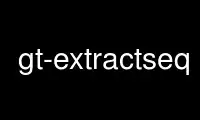
This is the command gt-extractseq that can be run in the OnWorks free hosting provider using one of our multiple free online workstations such as Ubuntu Online, Fedora Online, Windows online emulator or MAC OS online emulator
PROGRAM:
NAME
gt-extractseq - Extract sequences from given sequence file(s) or fastaindex.
SYNOPSIS
gt extractseq [option ...] [sequence_file(s)] | fastaindex
DESCRIPTION
-frompos [value]
extract sequence from this position counting from 1 on (default: 0)
-topos [value]
extract sequence up to this position counting from 1 on (default: 0)
-match [string]
extract all sequences whose description matches the given pattern. The given pattern
must be a valid extended regular expression. (default: undefined)
-keys [filename]
extract substrings for keys in specified file (default: undefined)
-width [value]
set output width for FASTA sequence printing (0 disables formatting) (default: 0)
-o [filename]
redirect output to specified file (default: undefined)
-gzip [yes|no]
write gzip compressed output file (default: no)
-bzip2 [yes|no]
write bzip2 compressed output file (default: no)
-force [yes|no]
force writing to output file (default: no)
-help
display help and exit
-version
display version information and exit
The option -keys allows one to extract substrings or sequences from the given sequence
file or from a fasta index. The substrings to be extracted are specified in a key file
given as argument to this option. The key file must contain lines of the form
k
or
k i j
where k is a string (the key) and the optional i and j are positive integers such that
i⇐j. k is the key and the optional numbers i and j specify the first position of the
substring and the last position of the substring to be extracted. The positions are
counted from 1. If k is identical to the string between the first first and second
occurrence of the symbol | in a fasta header, then the fasta header and the corresponding
sequence is output. For example in the fasta header
>tr|A0AQI4|A0AQI4_9ARCH Putative ammonia monooxygenase (Fragment)
the fasta key is A0AQI4. If i and j are both specified, then the corresponding substring
is shown in fasta format. In the latter case the header of the fasta formatted sequence in
the output begins with
>k i j
followed by the original original fasta header.
If the sequence input are fasta files, then the following holds:
· duplicated lines in the input file lead to only one sequence in the output
· the sequences are output according to the order in the original sequence files
· the formatting of the output can be controlled by the options -width, -o, -gzip, and
-bzip2
If the sequence input comes from a fasta index (see below), the following holds:
· option -width is required
· option -o, -gzip and -bzip2 do not work
· the sequences are output in the order the corresponding keys appear in the key file
If the end of the argument list only contains one filename, say fastaindex, then it is
checked if there is a file fastaindex.kys. This makes up part of the fasta index, which is
contructed by calling the suffixerator tool as follows:
gt suffixerator -protein -ssp -tis -des -sds -kys -indexname fastaindex \
-db inputfile1 [inputfile2 ..]
This reads the protein sequence files given to the option -db and creates several files:
· a file fastaindex.esq representing the sequence.
· a file fastaindex.ssp specifying the sequence separator positions.
· a file fastaindex.des showing the fasta headers line by line.
· a file fastaindex.sds giving the sequence header delimiter positions.
· a file fastaindex.kys containing the keys in the fasta files.
For the suffixerator command to work, the keys of the form |key| in the fasta header must
satisfy the following constraints:
· they all have to be of the same length, not longer than 128, and not shorter than 1
· they have to appear in lexicographic order
REPORTING BUGS
Report bugs to <[email protected]>.
Use gt-extractseq online using onworks.net services
